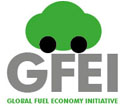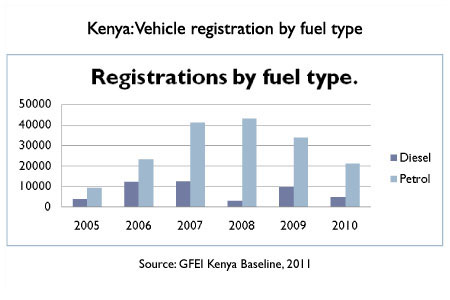
The Kenyan Developing Automotive Fuel Economy Policy
1.1 Background
According to its 2002 Initial National Communication to the UNFCCC, Kenya is a net CO2 sink, absorbing about 22,751Gg CO2 per year mainly due to the regeneration of forest and non-forest trees. However, this is quickly changing, as the same report also states Kenya’s charcoal production and consumption is believed to be emitting more GHGs (mainly CO2, CH4 and NOx) than the industry and transport sectors combined (Republic of Kenya 2002). And while per capita CO2 emissions remain low, the rapidly growing consumption of fossil fuels is quickly changing Kenya’s CO2 trajectory as demand for energy and mobility expands.
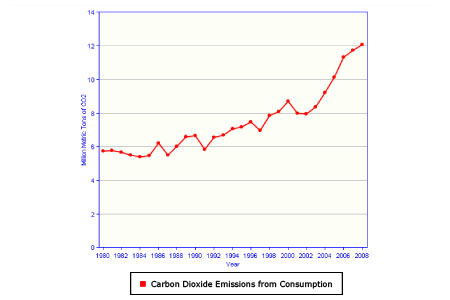
Credit : US EIA 2010
Over the years, the transport sector generally consumed 70% of the total net domestic sales of petroleum products, with the overall amount of petroleum demanded by the transport sector projected to rise from 1.9 million tonnes in 2004 to 8.6 million tonnes, 5.3 million tonnes and 6.8 million tonnes (depending on Business As Usual, Medium and Low scenarios) by 2030.
Projected transport petroleum demand, 2004-2030
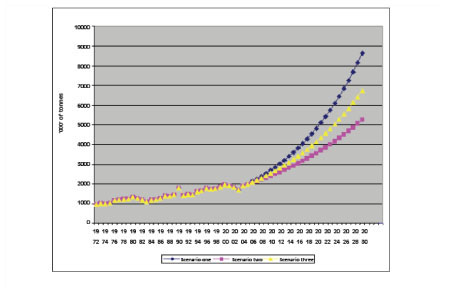
Credit : UNEP 2006
Kenya relies entirely on imported petroleum products, which accounted for 16% of the country’s import bill in 2002 and consumed 31% of the country’s foreign exchange earnings from merchandise exports that same year. The projected growth of demand is 2% yearly. Regulatory functions in the petroleum sector are shared among various players including the Ministry of Energy, provincial administrations, local authorities, the Kenya Bureau of Standards (KEBS), and the Petroleum Institute of East Africa (PIEA). Numerous studies have demonstrated that the transport sector, and in particular road transport, offers opportunities for savings on imported fuels through energy efficiency and fuel substitution.
1.2 Kenya’s Light-Duty Vehicle Fleet
Kenya does not have domestic vehicle production and relies on imports. The light duty vehicle stock saw an 85% increase from 1998-2008, with the majority (around 80%) of newly registered vehicles being second-hand imports from Japan (based on data from 2005 – 2010).
1.3 Status of LDV fleet fuel consumption/CO2 emissions
The country does not presently have auto fuel economy standards or vehicle emission standards in place. However, the elimination of leaded petrol in the country from 2006 and plans to reduce sulphur levels in fuels paves the way for cleaner, more efficient vehicles. Road transport is a major, and growing, source of air pollution in urban areas, especially particular matter.
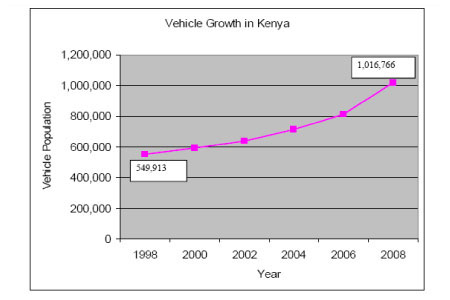
In 2010 the Global Fuel Economy Initiative supported the first-ever calculation of a national auto fuel economy baseline in Kenya from 2005. The majority of vehicles registered during the study period (2005-2010) are petrol powered and range in engine size of between 1500- 2000 cc.
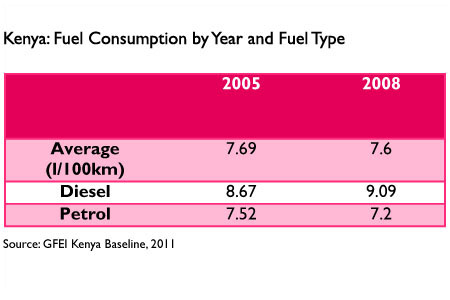
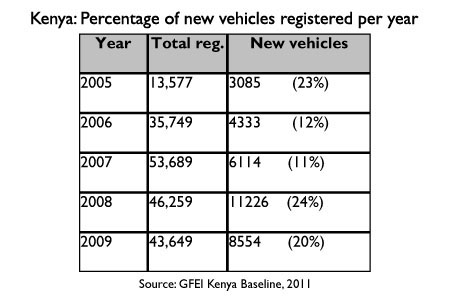
2.0 Regulatory Policies
2.1 National Standard
No auto fuel economy national standard.
2.2 Test Cycles type
N/A
2.3 Import restrictions
New Vehicles
All vehicles imported into Kenya are required to be no older than 8 years from year of manufacture. In mid 2011 Kenya’s Ministry of Finance announced an exemption of import duty for “environmentally friendly vehicles” and “battery operated vehicles”. However, it is unclear which exact vehicles will be exempt, whether this will include hybrid electric vehicles and/or conventional low emission vehicles.
Second Hand
Same as new vehicles, above.
2.4 Technology mandates/targets
None
3.0 Fiscal Measures and Economic Instruments
3.1 Fuel Taxes
Differentiated fuel taxes are in place, based on octane and quality.
3.2 Fee-bate
N/A
3.3 Buy-back
N/A
3.4 Other tax instruments
N/A.
3.5 Registration fees
N/A3.6 R&D
N/A4.0 Traffic Control Measures
4.1 Priority lanes
N/A4.2 Parking
N/A4.3 Road pricing
N/A5.0 Information
5.1 Labeling
N/A
5.2 Public info
N/A5.3 Industry reporting
N/AThe text above is a summary and synthesis of the following sources:
- Africa Environment Outlook 2, UNEP, http://www.unep.org/dewa/africa/aeo2_launch/
- Integrated assessment of the Energy Policy - with focus on the transport and household energy sectors, UNEP, 2006, http://www.unep.ch/etb/areas/pdf/Kenya%20ReportFINAL.pdf
- Kenya Institute for Public Policy Research & Analysis, A Comprehensive Study and Analysis on Energy Consumption Patterns in Kenya, 2010, http://www.cofek.co.ke/ERCStudy_ExecSummary_02082010.pdf
- Republic of Kenya, First National Communication of Kenya to the UNFCCC, http://unfccc.int/resource/docs/natc/kennc1.pdf
- US Energy Information Agency, Kenya Energy Profile, http://www.eia.gov/cfapps/country/country_energy_data.cfm?fips=KE
